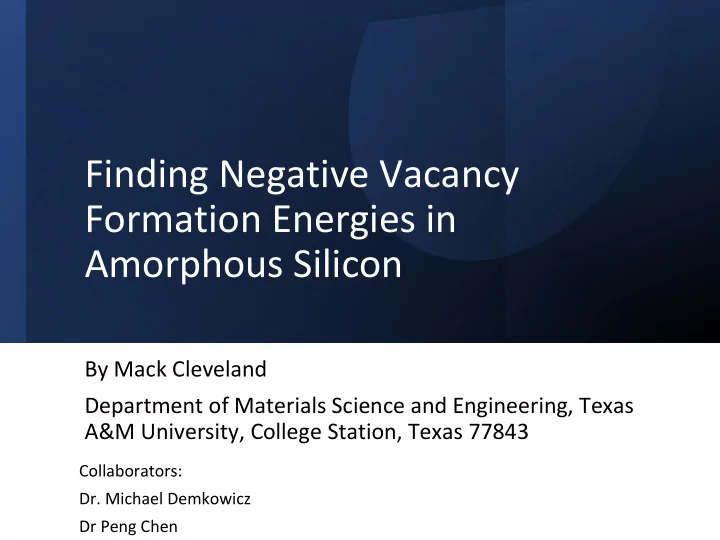

Finding Negative Vacancy Formation Energies in Amorphous Silicon By Mack Cleveland Department of Materials Science and Engineering, Texas A&M University, College Station, Texas 77843 Collaborators: Dr. Michael Demkowicz Dr Peng Chen
Introduction • Goal: determine whether Amorphous Silicon has negative vacancy formation energies. • Vacancies control diffusion in solids • Vacancy formation energies • Amorphous solids
Methodology • Using LAMMPS software to conduct atomic simulations of amorphous silicon structures • ADA Cluster at Texas A&M HPRC • 20 cores with 2560 MB for between 20 and 100 Hrs.
Project Overview 1. Melt and quench simulations 2. Preliminary vacancy formation energy calculation 3. Generalized atom removal energy calculations 4. Repeated calculations for varied simulation size 5. Self Interstitial formation energy calculations
Results • Vacancy Formation Energy Histograms Performing algorithm on a-Si structures of 1000 atoms cooled at rates of 10^10 and 10^12K/s.
Results • Atom removal Energy vs Atom Cohesion Energy
Results • ARE calculations for varied sizes
Results Self Interstitial formation Energies Crystal with one self interstitial Amorphous silicon quenched at 10^-12 K/S Amorphous silicon quenched at 10^-10 K/S
Conclusion • 1. S. Roorda, W. C. Sinke, J. M. Poate, D. C. Jacobson, S. Dierker, B. S. Dennis, D. J. Eaglesham, F. Spaepen, and P. Fuoss, Phys. Rev. B 44, 3702 (1991).
Acknowledgements • Dr. Michael Demkowicz and Dr. Peng Chen • Department of Energy, National Nuclear Security Administration. Award No. DE-NA0003857 • Center for Research Excellence of Dynamically Deformed Solids • Online REU Program at Texas A&M • HPRC at Texas A&M
Recommend
More recommend